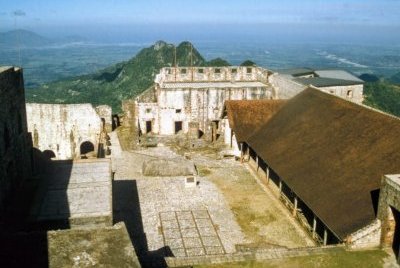
The Citadelle La Ferriere and Palace of Sans Souci near Cap Haitien are 2 of the most remarkable historical remains in the Americas. Seeing them is worthwhile both in itself and for the window it can provide on an amazing historical period and on the subsequent history of benighted Haiti through to its current troubles. I place them in my highest category of WHS “Worth a Journey”! (as opposed to “worth a detour” or a “visit”)
Haiti itself is a fascinating destination but perhaps not everyone’s taste – and, at the time of writing (Feb 2005..for the trip in Jan 2000), perhaps not totally safe. But, even if you don’t want to give Haiti a “full trip” then Cap Haitien itself is easily visited from the Dominican Republic. – allow a day to get there, a day to see the WHS and a day to get back. First take a bus or taxi to the border town of Dajabon – either from Santo Domingo or from one of the beach resorts on the NE coast. Walk across the border to Ouanaminthe and you are in a different world. You leave the Dominican Republic with its received US culture, its fast food chains, baseball and cast-off US Greyhound buses and enter the closest you will get to “Africa” on that side of the Atlantic. We were welcomed to Haiti with hens being sacrificed on the steps of the immigration hut. Your “bus” to Cap Haitien will probably be a lorry which you will share with a 100 others. In Cap Haitien you will be dropped in a crowded and poverty stricken market – you will wonder what you have got yourself into!!
In fact Cap Haitien has 2 nice and reasonably central hotels to which you can escape if you wish:- the “colonial” Roi Christophe and the Mont Joli. The WHS is about 20 kms away in Milot – get there either by taptap or by taxi (much easier if you are short of time – and he should wait or come back to pick you up as well).
In front of you are the remains of Henry Christophe’s Palace of Sans Souci, finally completed in 1813 and deliberately named after Frederick the Great’s palace in Potsdam. On 1 day in 1811 the self proclaimed King Henry I created 4 princes, 8 dukes, 22 counts 37 barons and 14 knights to “staff” his kingdom! In the halls and corridors of this Sans Souci the new nobility followed the rules of dress and behaviour laid out in Henry’s “Almanack Royal d’Haiti” - white tunic, red shoes, gold hilted sword etc. Varying colours delineated rank! The palace was ransacked after his downfall and destroyed by an earthquake in 1842 – but the outlines of its “Versailles-like” facades, stairs and colonnades are still there – a magical place.
5kms away and 900metres above the palace you will see the other great sight – The Citadelle. You might persuade your taxi to drive the first 3.5 kms (we didn’t!), alternatively walk or rent a horse. The road/track is flanked by Haitian houses and the walk enables you to meet the locals but it is a hot climb! Unlike the Palace, the Citadelle has been restored. Its “massiveness” is intimidating and the brutality involved in its construction can easily be imagined. Enormous piles of cannonballs still stand ready for use by the 100 cannons still in place. In fact the Citadelle never had to face the return of the French it was built to oppose. Inside you will see the burial place of King Henry – he committed suicide to avoid being captured by his fellow Haitians who rebelled in 1820 and his body was buried at his request in quicklime - a tablet marks the spot. The views over Haiti and the coast are magnificent.
The UNESCO site states “The Palace of Sans Souci, ….and, in particular, the Citadel serve as universal symbols of liberty, being the first monuments to be constructed by black slaves who had gained their freedom”. How wrong they are and what “politically correct” rubbish!!!
The following quote far better captures for me the essence of the places
“Sans Souci, a magnificent palace of brick and mortar .. .symbolised the early effort of the benevolent monarch to provide primitive Haiti with a lasting emblem of cultural leisure and good living. The Citadelle, on a peak of the range behind it, characterised the tyrant into whom Christophe grew. Threatening, useless, inaccessible, conceived in needless fear and militarily absurd, it was constructed at untold cost of toil, tears and blood” (Seldon Rodman)
More on
Comments
No comments yet.
